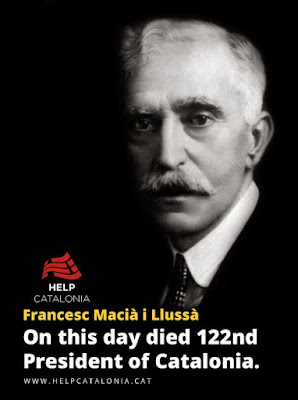Francesc
Macià i Llussà was the first President of the restored Generalitat de Catalunya
and held office from 1932 until his death in 1933. Over 1,000,000
attended to the Macià's funeral and flowers filed 120 automobiles at
burieal of President of the Catalan Government as the New York Times
explained.
Born in September 1859, Macià grew up in Vilanova i la Geltrú (a medium sized town approximately 50 kilometres south of Barcelona). After a spell in the Spanish army, he fought for Catalan independence and formed the political party Estat Català which later merged with other pro-independence groups to form Esquerra Republicana de Catalunya (Republican Left Wing of Catalonia).
Portrait of Francesc Macia
About the Artist
In 1931 the ERC won local elections and proclaimed the Catalan Republic. Three days later the Catalan Republic was restructured as the Generalitat de Catalunya (Government of the autonomous Catalonia) with Francesc Macia as president and the statute was drawn up.
Monument to Francesc Macià
This unusual monument is the work of Josep Maria Soberachs and was inaugerated in 1991. The mostly abstract statue consists of a bronze bust of Macià in front of an inverted concrete staircase. The unfinished staircase symbolises the ongoing history of Catalonia which is being constructed day-by-day.
Josep Maria Soberachs was born in Barcelona in 1927. He was a multidisciplinary artist, painter, sculptor, illustrator and art critic whose best known works include the Passion Façade of the Sagrada Familia Basilica.

Read more »

Read more »

Read more »
Born in September 1859, Macià grew up in Vilanova i la Geltrú (a medium sized town approximately 50 kilometres south of Barcelona). After a spell in the Spanish army, he fought for Catalan independence and formed the political party Estat Català which later merged with other pro-independence groups to form Esquerra Republicana de Catalunya (Republican Left Wing of Catalonia).
Portrait of Francesc Macia
About the Artist
In 1931 the ERC won local elections and proclaimed the Catalan Republic. Three days later the Catalan Republic was restructured as the Generalitat de Catalunya (Government of the autonomous Catalonia) with Francesc Macia as president and the statute was drawn up.
Monument to Francesc Macià
This unusual monument is the work of Josep Maria Soberachs and was inaugerated in 1991. The mostly abstract statue consists of a bronze bust of Macià in front of an inverted concrete staircase. The unfinished staircase symbolises the ongoing history of Catalonia which is being constructed day-by-day.
Josep Maria Soberachs was born in Barcelona in 1927. He was a multidisciplinary artist, painter, sculptor, illustrator and art critic whose best known works include the Passion Façade of the Sagrada Familia Basilica.
Francesc Macià, President of the Catalan Republic

Social
and Democratic Commitment On the 25th of December 1933, the President
of Catalonia Francesc Macià died at the Palace of the Generalitat, the
seat of the Catalan Government in the very heart of the city of
Barcelona. Enormously popular, as proven by his landslide election
victory of 1931, Macià was seen off by an enormous...
The Catalan Government: an Historical and Democratic Legitimacy

In
the ongoing so-called Catalan process for democracy and in the face of
the Spanish government's denial of it —along with that of the vast
majority of the Spanish political class— there are some who have tried
to focus the debate solely on legality versus legitimacy, ignoring all
too often that this is also a debate on popular will versus...
The Catalan Republic and the Generalitat de Catalunya
20th
Century AC The fall of the regime of Miguel Primo de Rivera gave way to
a ‘soft dictatorship’. The weakness of the government which was led by
admiral Aznar and General Berenguer propelled the convocation of
municipal elections in April 1931; these elections would deeply mark the
evolution of the region over the succeeding years. General...






















0 comentaris:
Publica un comentari a l'entrada